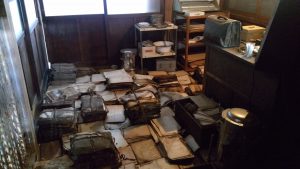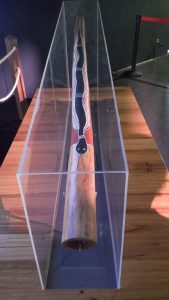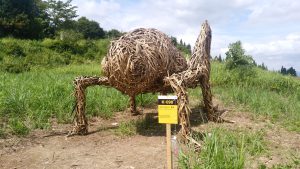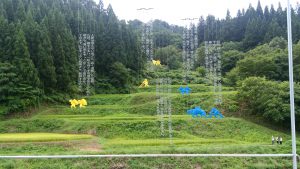開催期間残り僅か!『大地の芸術祭2018』②/Only few time remaining “ECHIGO-TSUMARI ART FIELD 2018” ②
The triennial ‘Echigo-Tsumari Art Triennale’ is almost coming to an end! We believe it will provide new insights and inspiration even to those who have never been interested in contemporary art. Please find the time to visit the site and experience it firsthand.
(English text continues to the latter half of the page)
前回に続き越後妻有の『大地の芸術祭2018』の報告です。3年に一度の芸術祭も9月15日までと残り僅かになっています。今からでも決して遅くはないので、ぜひ一度ご訪問ください。
空き家を活用したアート作品
十日町の国道117号線沿いにある元々水車小屋だった空き家の中に展開する「からむしの家」。からむしは麻の一種でかつてのこの地方の特産品。小屋の中では動画のような世界が展開しています。


韓国人アーティストの手による「ドクターズ・ハウス」。松代から山奥に入った集落にあるこの空き家は近年まで代々お医者さんが住んでいました。現在ほど公共交通の発達していなかった時代に、人里離れた山奥の集落にとって医者の存在は特別なものでした。今は空き家となったこの家の中に様々な仕掛けを施して、医者と言う特別な存在感を表現しています。

銀のシートで覆った廊下。

床に穿った空間に置かれたオブジェ。“記憶の井戸”を表すのか。


こうした部屋は医院だった頃の面影を残しています。
これは「中国ハウス」。名前通り中国人観光客でいっぱいでした。

十日町の外れにある空き家を改修した「中国ハウス」は家の壁前面に毛筆で描かれたデザインが縦横無尽に展示されています。下の動画は部屋中を360度に撮影したもの。
人々の生活に寄り添うアート
アート作品の中には住民たちの生活の場に寄り添ったものも数多くあります。


ほくほく線の土市駅の前に作られた「Kiss&Goodbye・思い出ポスト」。台湾出身のアーティストによる作品で、駅舎の脇に置かれたポストに作者デザインによる“幸せのメッセージカード”を見学者に投函してもらい、ハーフドーム型の建物の中では作者の絵本をアニメ化した映像が流れています。


この2つの岩は同じほくほく線の無人駅、魚沼中条駅の脇に置かれています。タイトルは「目 Repetitive objects」。一体何が特別なんだろうとよく観ると、何とこの二つの岩はその形、大きさ、苔のパターンまで寸分たがわずまったく同じ!無造作に自然石を置いただけだと思ったのですが、そっと近づいてみると樹脂製の作りものでした。これは騙された。
この日はちょうど夏祭りの日、岡の上の神社に神輿が入っていこうとしています。



この神社の社屋の中に「アトラスの哀歌」というアート作品が展示されています。中から提灯のように照らされた和紙でできた地球儀がそれぞれ独自に回転しています。作者は17歳でチリから政治亡命したアーティスト。現在はフランスに住む彼女がグローバルな「放浪・亡命・移動」をテーマにしつつ、チリへの郷愁を抱いた作品だそうです。
各展示拠点の作品
ここからは各所に設けられた展示拠点の作品を並べてみます。

ここが松代の「農舞台」。芸術祭の本部にあたるところです。

棚田に展開するお馴染みのオブジェ。


今回はオーストラリア特集でしたね。アボリジニーの伝統楽器ディジュリドゥと音響展示が豊富でした。下の動画は同楽器の演奏と、楽器の最大の特徴である空気の振動を床の反響版で体験できる仕掛け。
こちらは十日町市の「越後妻有里山現代美術館 キナーレ」。芸術祭の期間中にはテーマに従って様々なアート展示が並びます。

施設の中央は大きなプールになっています。泳ぐのは禁止ですが、水に浸るのはOK。
十日町のお隣、川西のナカゴグリーンパークも芸術祭の期間中に多くの展示が並びます。

このエリアの象徴的作品「光の館」。アメリカ人アーティストのジェームズ・タレル氏によるもの。宿泊施設としても活用されており、最大の特徴は自然光の取り込みで、屋根が稼働し下の動画のように天井をそのまま青空にすることができます。

「光の館」の入り口付近では、こんな竹で編んだ巨大な昆虫が迎えてくれます。
グリーンパークの中には様々な展示がされています。お子様連れでも楽しそう。







実は最後の猫の行列が一番気に入っています。一匹として同じ顔をした猫がいない。恐らく作者は猫を飼っている方に違いない。
3年に一度の『大地の芸術祭』も残りあと僅か!現代アートにこれまで興味の無かった方々にも新しい気づきと感動を与えてくれると考えています。ぜひ時間を見つけて現場に足を運んでみてください。
The triennial ‘Echigo-Tsumari Art Triennale’ is almost coming to an end! We believe it will provide new insights and inspiration even to those who have never been interested in contemporary art. Please find the time to visit the site and experience it firsthand.
Continuing from the previous update, here is a report on the ‘Echigo-Tsumari Art Triennale 2018’. The triennial art festival is now approaching its end on September 15th, but it’s not too late to visit. Please take the opportunity to experience it firsthand.
Artworks Utilizing Vacant Houses
Inside the vacant house along National Route 117 in Tōkamachi, formerly a watermill, you’ll find the ‘Karamushi House.’ Karamushi, a type of hemp, was once a local specialty of this area. Inside the house, a world resembling a video unfolds.

The ‘Doctor’s House’ is the work of a Korean artist. This vacant house, located in a mountain village deep inside Matsudai, was home to generations of doctors until recent years. In a time when public transportation was not as developed as it is today, the presence of a doctor in a remote mountain village was something truly special. Now vacant, the house is filled with various installations that express the unique presence and significance of the doctor.


A hallway covered with silver sheets.

An object placed in a space carved into the floor—perhaps representing a ‘Well of Memories.’


These rooms still retain the traces of when the house was a clinic.

This is the ‘China House,’ which, true to its name, was filled with Chinese tourists.
Located on the outskirts of Tōkamachi, the ‘China House’ is a renovated vacant house where calligraphy designs are displayed extensively on the walls. The video below captures a 360-degree view of the rooms.
Art that resonates with people’s everyday lives
Some art pieces are closely connected to the daily lives of the local residents.


In front of Doichi Station on the Hokuhoku Line, you’ll find the ‘Kiss & Goodbye Memory Post.’ Created by a Taiwanese artist, this work invites visitors to place ‘messages of happiness’ designed by the artist into a postbox placed beside the station. Inside a half-dome-shaped structure nearby, an animation of a picture book by the artist is displayed.


These two rocks are located beside Uonuma Nakajō Station, an unmanned station on the Hokuhoku Line. Titled ‘Eyes – Repetitive Objects,’ at first glance, they seem like ordinary natural stones. However, upon closer inspection, you’ll notice that the rocks are identical in shape, size, and even the moss patterns on them. Surprisingly, they are made of resin, not stone. I was fooled!

On this day, it was the summer festival, and a portable shrine was just entering the shrine on the hill.


Inside the shrine’s building, there’s an art piece called ‘Atlas’s Lament.’ Illuminated like lanterns, globes made of washi paper rotate independently within. The artist, who fled political persecution in Chile at the age of 17 and now lives in France, created this work as an exploration of global themes like ‘wandering, exile, and movement,’ while also expressing a sense of nostalgia for Chile.
Artworks at Various Exhibition Sites
From here, let’s take a look at the artworks displayed at each exhibition site.

This is the ‘Nobutai’ in Matsudai, which serves as the headquarters for the art festival.

An iconic object spread across the terraced rice fields.

This year featured a special focus on Australia. There were many sound installations, including performances of the traditional Aboriginal instrument, the didgeridoo. The video below shows a didgeridoo performance, where you can experience the air vibrations through a reflective floor panel, which is the instrument’s unique feature.
Here is the ‘Echigo-Tsumari Satoyama Museum of Contemporary Art, KINARE’ in Tokamachi City. During the festival, various art exhibitions are held according to different themes.

The center of the facility features a large pool. Swimming is not allowed, but you are welcome to dip your feet in.
In the neighboring town of Kawanishi in Tokamachi, Nakago Green Park also hosts many exhibitions during the festival.

The iconic artwork of this area is the ‘House of Light,’ created by the American artist James Turrell. It also functions as a lodging facility, with its main feature being the integration of natural light. The roof can be moved, as shown in the video below, to open the ceiling directly to the sky.

Near the entrance to the ‘House of Light,’ you’ll be greeted by giant insects woven from bamboo.

Various exhibits are displayed throughout Green Park. It seems like a fun place to visit with children.





Actually, the last procession of cats is my favorite. Not a single cat has the same face. I suspect the artist must be someone who keeps cats.
The triennial ‘Echigo-Tsumari Art Triennale’ is almost over! We believe it will provide new insights and inspiration even for those who haven’t been interested in contemporary art before. Please make time to visit the site if you can.
